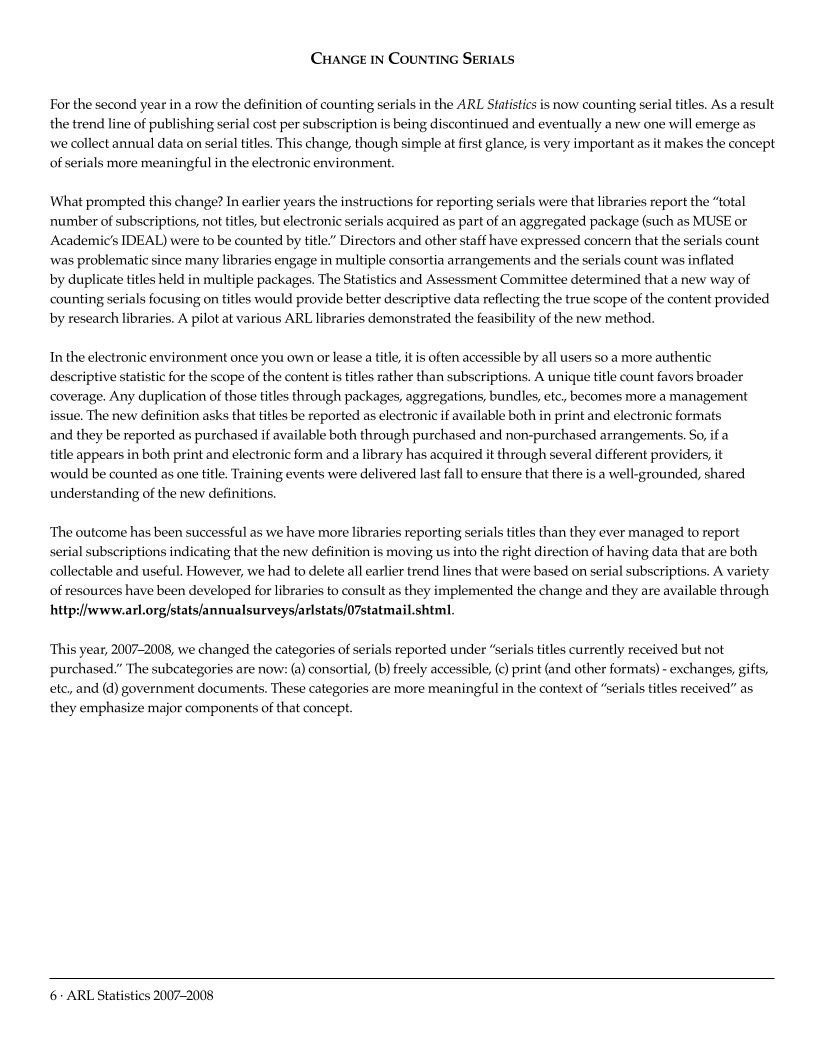6 · ARL Statistics 2007–2008
Change in Counting Serials
For the second year in a row the definition of counting serials in the ARL Statistics is now counting serial titles. As a result
the trend line of publishing serial cost per subscription is being discontinued and eventually a new one will emerge as
we collect annual data on serial titles. This change, though simple at first glance, is very important as it makes the concept
of serials more meaningful in the electronic environment.
What prompted this change? In earlier years the instructions for reporting serials were that libraries report the “total
number of subscriptions, not titles, but electronic serials acquired as part of an aggregated package (such as MUSE or
Academic’s IDEAL) were to be counted by title.” Directors and other staff have expressed concern that the serials count
was problematic since many libraries engage in multiple consortia arrangements and the serials count was inflated
by duplicate titles held in multiple packages. The Statistics and Assessment Committee determined that a new way of
counting serials focusing on titles would provide better descriptive data reflecting the true scope of the content provided
by research libraries. A pilot at various ARL libraries demonstrated the feasibility of the new method.
In the electronic environment once you own or lease a title, it is often accessible by all users so a more authentic
descriptive statistic for the scope of the content is titles rather than subscriptions. A unique title count favors broader
coverage. Any duplication of those titles through packages, aggregations, bundles, etc., becomes more a management
issue. The new definition asks that titles be reported as electronic if available both in print and electronic formats
and they be reported as purchased if available both through purchased and non-purchased arrangements. So, if a
title appears in both print and electronic form and a library has acquired it through several different providers, it
would be counted as one title. Training events were delivered last fall to ensure that there is a well-grounded, shared
understanding of the new definitions.
The outcome has been successful as we have more libraries reporting serials titles than they ever managed to report
serial subscriptions indicating that the new definition is moving us into the right direction of having data that are both
collectable and useful. However, we had to delete all earlier trend lines that were based on serial subscriptions. A variety
of resources have been developed for libraries to consult as they implemented the change and they are available through
http://www.arl.org/stats/annualsurveys/arlstats/07statmail.shtml.
This year, 2007–2008, we changed the categories of serials reported under “serials titles currently received but not
purchased.” The subcategories are now: (a) consortial, (b) freely accessible, (c) print (and other formats) -exchanges, gifts,
etc., and (d) government documents. These categories are more meaningful in the context of “serials titles received” as
they emphasize major components of that concept.
Change in Counting Serials
For the second year in a row the definition of counting serials in the ARL Statistics is now counting serial titles. As a result
the trend line of publishing serial cost per subscription is being discontinued and eventually a new one will emerge as
we collect annual data on serial titles. This change, though simple at first glance, is very important as it makes the concept
of serials more meaningful in the electronic environment.
What prompted this change? In earlier years the instructions for reporting serials were that libraries report the “total
number of subscriptions, not titles, but electronic serials acquired as part of an aggregated package (such as MUSE or
Academic’s IDEAL) were to be counted by title.” Directors and other staff have expressed concern that the serials count
was problematic since many libraries engage in multiple consortia arrangements and the serials count was inflated
by duplicate titles held in multiple packages. The Statistics and Assessment Committee determined that a new way of
counting serials focusing on titles would provide better descriptive data reflecting the true scope of the content provided
by research libraries. A pilot at various ARL libraries demonstrated the feasibility of the new method.
In the electronic environment once you own or lease a title, it is often accessible by all users so a more authentic
descriptive statistic for the scope of the content is titles rather than subscriptions. A unique title count favors broader
coverage. Any duplication of those titles through packages, aggregations, bundles, etc., becomes more a management
issue. The new definition asks that titles be reported as electronic if available both in print and electronic formats
and they be reported as purchased if available both through purchased and non-purchased arrangements. So, if a
title appears in both print and electronic form and a library has acquired it through several different providers, it
would be counted as one title. Training events were delivered last fall to ensure that there is a well-grounded, shared
understanding of the new definitions.
The outcome has been successful as we have more libraries reporting serials titles than they ever managed to report
serial subscriptions indicating that the new definition is moving us into the right direction of having data that are both
collectable and useful. However, we had to delete all earlier trend lines that were based on serial subscriptions. A variety
of resources have been developed for libraries to consult as they implemented the change and they are available through
http://www.arl.org/stats/annualsurveys/arlstats/07statmail.shtml.
This year, 2007–2008, we changed the categories of serials reported under “serials titles currently received but not
purchased.” The subcategories are now: (a) consortial, (b) freely accessible, (c) print (and other formats) -exchanges, gifts,
etc., and (d) government documents. These categories are more meaningful in the context of “serials titles received” as
they emphasize major components of that concept.
























































































































































